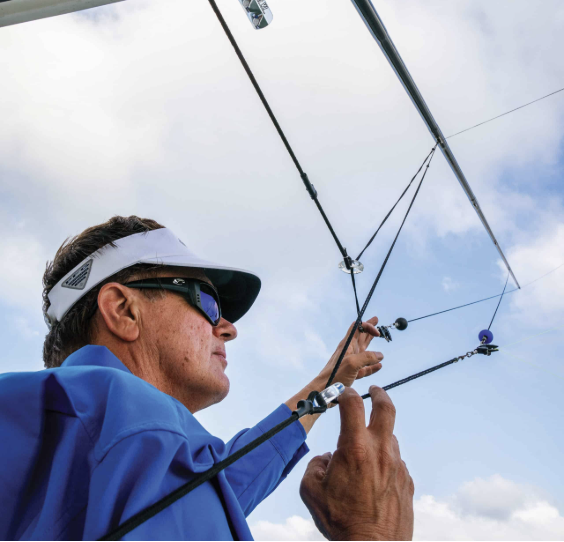Summer boat rigging problems are more common than most boaters realize. When the summer boating season hits full throttle, your outboard boat’s rigging components are pushed to their limits. Whether you’re chasing tarpon off the coast or heading to a sandbar with the family, summer heat, saltwater, and extended use can wear down your boat’s rigging fast—often without warning. Below are the most common rigging issues we see on outboard-powered boats in the summer, along with expert tips to help you prevent breakdowns, costly repairs, or worse—getting stranded. Visit our service department today for expert help.
1. Heat-Stressed Hydraulic Steering Systems
What Fails:
High temps and prolonged engine use can cause hydraulic fluid expansion, leaks at fittings, or degraded seals. Steering may start to feel “soft” or unresponsive—especially on dual or triple outboard setups.
How to Prevent It:
- Check hydraulic fluid level monthly (especially in summer).
- Inspect the helm pump and cylinder for leaks or residue.
- Use manufacturer-recommended fluids only.
- Consider a full flush and fluid replacement if over 2 years old.
2. Wiring and Connector Failures from UV & Salt Exposure
What Fails:
Summer brings UV rays, salt spray, and humidity—triple threats to your electrical rigging. Worn insulation, corroded connectors, or overheating can knock out critical systems like trim, lighting, or electronics.
How to Prevent It:
- Inspect exposed wiring monthly for cracks, wear, or green corrosion.
- Use dielectric grease on plug connections and battery terminals.
- Replace standard butt connectors with heat-shrink marine-grade versions.
- Secure all wiring away from sharp edges and vibration-prone areas.
3. Outrigger Rigging Fatigue and Hardware Failures
What Fails:
Outriggers are a staple for serious offshore anglers, but during summer, their rigging lines and mounts face intense UV, vibration, and repeated stress from trolling. We often see frayed halyards, seized pulleys, and loosened base mounts this time of year.
How to Prevent It:
- Inspect halyards and tensioners for chafe, UV damage, or slack lines.
- Lube all pulley blocks and roller guides to prevent salt-related seizure.
- Ensure outrigger bases and arms are torque-tight and corrosion-free.
- If collapsible, make sure the locking mechanisms are clean and secure.
💡 Pro Tip: If you hear squeaking or rattling at speed, your outrigger mounts may be working loose—tighten and check before your next trip.
4. Loose or Rusted Mounting Hardware
What Fails:
Vibration from wave chop, trailering, and high-speed runs can loosen mounting bolts on:
- Outboard motors
- Jack plates
- Power poles and trim tabs
- T-tops and leaning posts
How to Prevent It:
- Torque-check engine mount bolts and jack plates monthly.
- Inspect aluminum brackets and stainless bolts for pitting or rust streaks.
- Re-tighten hardware after every long trailer trip.

5. Rigging Tube Wear & Water Intrusion
What Fails:
Rigging tubes that house steering, fuel, and electrical lines can crack under UV stress or chafe internally. Once they’re breached, saltwater intrusion can lead to short circuits or fuel line degradation.
How to Prevent It:
- Inspect tubes where they exit the transom or enter rigging ports.
- Replace any showing cracks, flaking, or stiffness.
- Use marine chafe protection sleeves where lines enter rigging holes.
6. Accessory Rigging Failures (P-Poles, T-Tops, Livewells)
What Fails:
With more summer boating comes heavier use of accessories like:
- Power poles or shallow water anchors
- Livewell pumps and wiring
- T-tops with lighting or speakers
Overloaded or improperly rigged systems can fail suddenly, especially in rough seas or summer storms.
How to Prevent It:
- Test livewell pumps and aerators weekly—replace noisy or sluggish ones.
- Check that Power Pole lines and pumps are tight and leak-free.
- Inspect T-top hardware and wiring for loose bolts and cracked seals.
7. Trailer Rigging
What Fails:
Don’t forget your trailer—it’s often the most overlooked part of your rigging. Summer heat, saltwater dunking, and long hauls can destroy:
- Brake lines
- Winch straps
- Wiring harnesses
- Bunk brackets and guides
How to Prevent It:
- Inspect the winch strap and safety chain for frays or rust.
- Check that lights and brakes function before every trip.
- Rinse with freshwater after every launch and grease your hubs regularly.
Ready for the Water? Let’s Make Sure.
The truth is, summer is tough on boats—and even tougher on rigging. From your hydraulic steering to your outrigger pulleys and trailer brakes, every component has a role in keeping you safe and running smooth. The more time you spend on the water, the more wear these parts endure. A small issue today can quickly become a big problem tomorrow.
That’s why we always recommend a pre-season or mid-summer rigging inspection, especially if you’re hitting the water every weekend.
At Black Label Marine Group, our service team knows exactly what to look for. We offer:
- Full rigging inspections for outboards and accessories
- Hydraulic steering checks and fluid service
- Electrical and wiring diagnostics
- Power Pole, T-top, and trailer system checks
- Outrigger tuning and rigging replacements
Whether you’re heading offshore or just cruising the intercoastal, let us help you catch problems before they leave you stranded.
👉 Schedule your service visit today or stop by any of our Black Label Marine Group locations to speak with our expert techs.
Common issues include hydraulic steering leaks, corroded wiring, outrigger wear, loose engine mounts, cracked rigging tubes, and trailer failures. As a result, breakdowns often happen without warning if these areas go unchecked.
Look for soft steering, fluid leaks, or reduced responsiveness. In particular, dual or triple outboards may show signs faster due to added pressure.
Check rigging before each trip. Additionally, do a full inspection monthly—especially during peak use.
Inspect halyards, lube pulleys, and tighten mounts. If neglected, failures can happen offshore when stress levels are highest.



